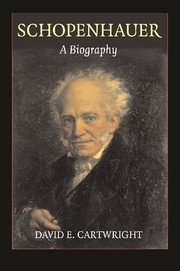Book contents
- Frontmatter
- Contents
- Preface
- Acknowledgments
- Notes on the Text
- Chronology of Schopenhauer's Life and Works
- 1 The Affirmation of the Will
- 2 A Tour for a Trade
- 3 A Father's Death; A Philosopher's Birth
- 4 The University Years
- 5 The Better Consciousness, Causes, Grounds, and Confrontations
- 6 Goethe, Colors, and Eastern Lights
- 7 The Single Thought of Dresden
- 8 Failure in Berlin
- 9 Ich Bin Kein Berliner
- 10 The Frankfurt Philosopher
- 11 The Dawn of Fame and the End of Life
- Works Cited
- Index
7 - The Single Thought of Dresden
Published online by Cambridge University Press: 05 April 2014
- Frontmatter
- Contents
- Preface
- Acknowledgments
- Notes on the Text
- Chronology of Schopenhauer's Life and Works
- 1 The Affirmation of the Will
- 2 A Tour for a Trade
- 3 A Father's Death; A Philosopher's Birth
- 4 The University Years
- 5 The Better Consciousness, Causes, Grounds, and Confrontations
- 6 Goethe, Colors, and Eastern Lights
- 7 The Single Thought of Dresden
- 8 Failure in Berlin
- 9 Ich Bin Kein Berliner
- 10 The Frankfurt Philosopher
- 11 The Dawn of Fame and the End of Life
- Works Cited
- Index
Summary
Dresden provided a safe haven for Schopenhauer's conflicted life. He abandoned Weimar, deeply wounded by his mother's rejection, and he sought refuge in this Saxon city of around fifty thousand souls, a city with which he was familiar even before his family reposed there for ten days at the close of the European tour. At that earlier time, he found the city “beautiful and interesting,” and he savored its picture gallery and robust natural beauty. It is likely that upon his return he revisited the “magnificent Catholic church” to re-experience its “glorious church music,” which moved the young man to attend High Mass twice in 1804. Much later, he would recommend the use of a large organ, reduced to the very limits of audibility, to constantly lay down the ground-bass and thereby to enhance the effect of the orchestra, “as is done in the Catholic church in Dresden.” Yet if his heart hurt from his experience with his mother, his head was alive, focused on color, the sunrise of the East, and the foundational ideas for his system of philosophy. In Dresden he would practice what he would soon preach; the head as the cure for the pangs of the heart and the intellect's triumph over the will. And although Dresden was his home for only fifty-two months, from the end of May 1814 to the end of September 1818, it became the permanent home ground for his philosophical thought.
- Type
- Chapter
- Information
- SchopenhauerA Biography, pp. 277 - 335Publisher: Cambridge University PressPrint publication year: 2010



